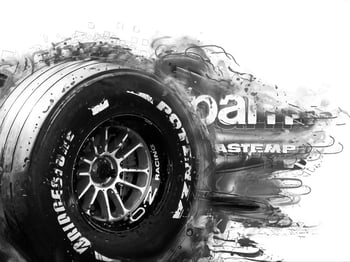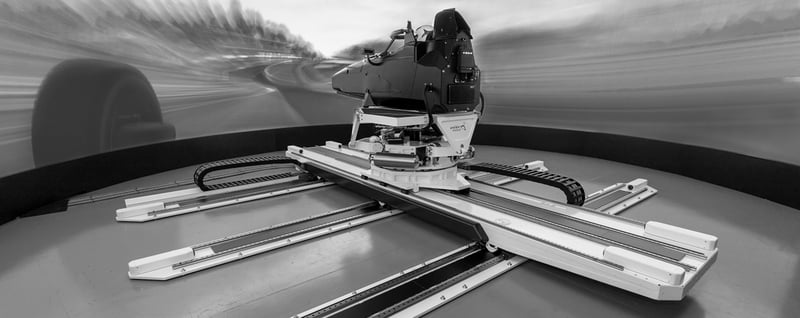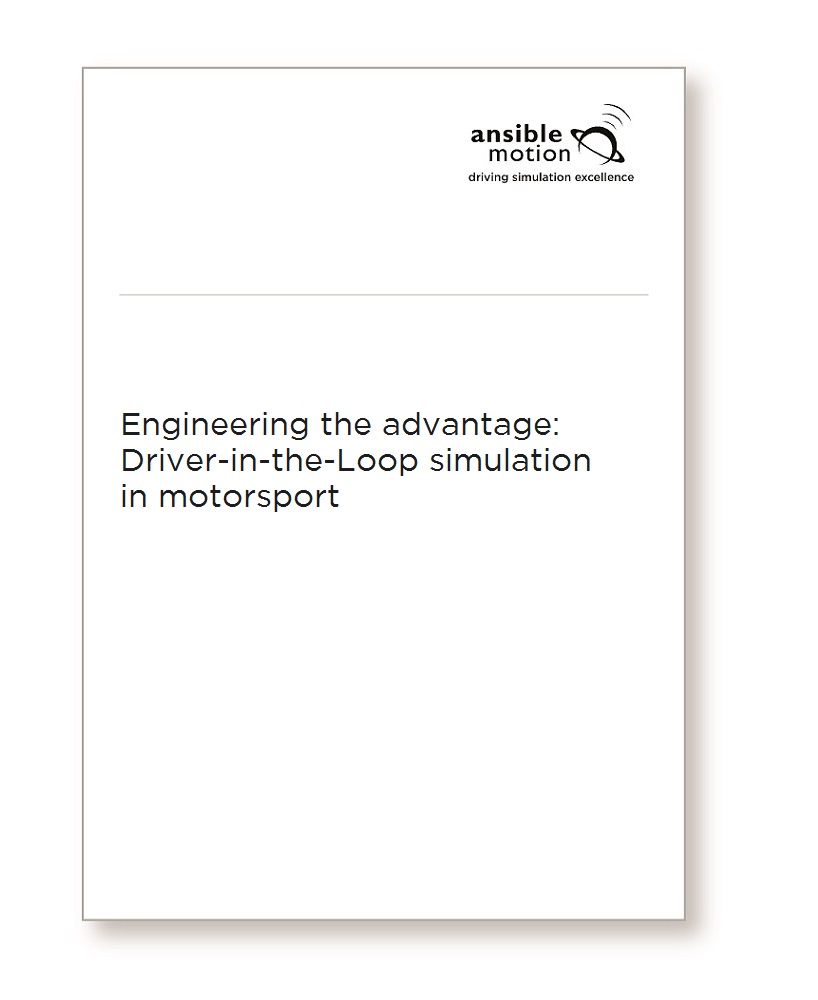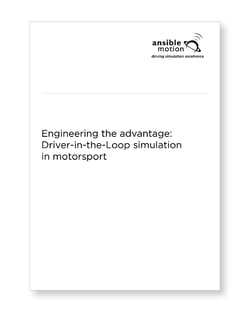Introduction
 Motorsport is a quest for the all-important competitive advantage. From the initial design of the car and the preparation of the driver, through to setup choices, strategy decisions and energy management, every single aspect of a successful competition programme comes down to utilising resources as effectively as possible.
Motorsport is a quest for the all-important competitive advantage. From the initial design of the car and the preparation of the driver, through to setup choices, strategy decisions and energy management, every single aspect of a successful competition programme comes down to utilising resources as effectively as possible.
To complicate matters, professional-level motorsport is a highly dynamic environment. Rules are continually changing, technology is evolving, and in some categories the cars can receive significant updates from one race to the next. Consequently, it’s not always possible to work through each of these challenges with real-world testing alone.
Next come the issues of cost, logistics and privacy. For example, teams may need to transport cars to suitable test venues in the winter months, book private test sessions and, in some cases, join hosted test sessions where competing teams may be present. But more fundamentally, most series now impose strict limits on all forms of real-world testing.
All this has placed added emphasis on the use of simulation. At the same time, more affordable computing power, improved hardware and growing expertise has pushed the benefits of many different simulation technologies, including Driver-in-the-Loop (DIL) simulation.
In this paper, we’ll discuss some of the challenges faced by race teams, as well as the relevance and practicality of DIL simulation. The three main types of DIL simulators are defined and described, and a DIL simulator selection checklist is provided to help race engineers, technical directors, programme managers and other stakeholders assess various DIL simulator technologies.
Being prepared
Modern motorsport is as much an exercise in preparation and strategy as anything else. In order to score points on race day and ultimately be successful, teams must train their drivers and tune their vehicles more efficiently than their competitors.
Off-line simulation is a part of the approach. Vehicle and environment variables can be modelled in the virtual world, and digital development can be carried out before the team even ventures onto a race track. This not only allows more tuning changes to be explored earlier in the process, but it allows concepts to be explored more deeply and efficiently. This has the potential to eliminate much of the trial and error testing that can otherwise consume what little time is available at the track.
Equipment such as shaker rigs, wind tunnels and tyre characterisation equipment can provide valuable information that can be used to capture and analyse the behaviour of certain aspects of a racecar. These are repeatable, structured laboratory test methods that are useful for mapping specific vehicle performance characteristics. But ultimately, they only provide a fingerprint of a racecar in isolation. Remaining is the riddle of what will happen when a driver climbs aboard and seeks to explore performance limits in the complex and unpredictable real world.
As Pirelli’s former Director of Motorsport, Paul Hembery explains:
"You can probably get 80 per cent of the way there via the simulation that we do and the Flat-Trac [tyre] testing, but that final piece has such an impact. That’s the area where you need to be doing track miles."
Download this eBook as a PDF
Closing the loop
For many years, the only way to introduce the final, human element was to place a real car with a real driver on a real track. It’s this human aspect – a driver’s ability to perceive subtle changes and react to them accordingly – that closes the control loop between a car and its environment. These days, this can be accomplished with a DIL simulator.
Using a DIL simulator, race day strategies and trackside working practices can be explored in a repeatable, controlled laboratory environment operating 24/7. This captures an ideal balance between the deterministic nature of offline laboratory testing and the reactive elements introduced by human drivers navigating on real race tracks – Hembery’s remaining 20 per cent, cited above. DIL simulators give race engineers complete control over what varies and what stays the same, all of which can be recorded and analysed in detail using the same telemetry and data analysis tools that are used track-side.
Speaking in 2019, Nick Yelloly, test and simulator driver for Racing Point F1 Team explains:
"I think I spend about 60 to 70 days a year in the simulator. The work can vary from simulator development, to car development and testing different setups."
It is also worth noting that the use of DIL simulators opens entirely new possibilities that may not even be possible within the realm of real testing or racing. For example, there’s no need to wait for a real rainstorm because weather variations can be conjured up with the touch of a button; multiple tyres can be driven in rapid succession; a virtual race track can even be set up to loop one particularly critical track segment continuously without the need to complete the remainder of the real lap in between.
Democratising simulation
Until relatively recently, DIL simulators in motorsport were the preserve of the privileged few, a handful of Formula 1® teams with the financial resources to design and build their own simulators from scratch.
At least one Formula 1® team is rumoured to have spent as much as $40 million (USD) in the early 2000s in order to hybridise aerospace simulator technologies for their purposes. They did so with very good reason, since the technology required to build an engineering-class DIL simulator simply wasn’t available off the shelf at that time.
Although previous motorsport-capable driving simulators were cost and resource prohibitive for most race teams – and even many OEMs – the landscape has now changed. Specialty providers are now creating DIL simulators that are designed expressly for high-dynamic automotive simulation and they are an order of magnitude less expensive than previous generations of driving simulators. The net result is that Driver-in-the-Loop simulation has become a practical and affordable tool in motorsport, accessible to many teams and organisations.
Types of DIL simulators
Modern DIL simulators range in size, complexity, performance and cost. To simplify matters they can be broadly classified into three categories: Entertainment DIL, Human Factors DIL, and Engineering DIL.
Entertainment DIL
Entertainment-class driving simulators can provide graphical and driver interface realism and large libraries of ready-to-go race tracks and vehicle models. While gaming graphics can be quite stunning, the vehicle physics and driver sensory feedback is greatly simplified. Therefore, these simulators are typically not used by race engineers or vehicle constructors. The most practical use case is to assist professional and amateur drivers with race track familiarisation.
Human Factors DIL
Human-Factors-class driving simulators deliver a more realistic driving experience by providing a more immersive cockpit environment, better vision systems and potentially some level of motion cueing. However, the focus is generally on investigations where vehicle dynamics performance is not a critical factor, such as Human-Machine Interface (HMI) development. Generally, these DIL systems are large, slower-moving installations with some supplemental mechanical and/or acoustic vibration elements that are not necessarily designed to mimic the physical forces encountered in motorsport.

Engineering DIL
Engineering-class driving simulators deliver compelling driver immersion via high performance motion and vision systems, as well as comprehensive tool suite connectivity. These DIL simulators typically have medium-size form factors, and are directed towards satisfying the needs of professional drivers and race engineers. These simulators are designed specifically for use in automotive and motorsport applications. They typically rely on structural composites and other lightweight materials to deliver the low mass and high stiffness required to accurately deliver high-dynamic motion cues; they use low-latency motion systems such as stratiform machines, with tune-able motion cueing strategies that provide independent movement for all vehicle axes; they offer sophisticated graphical rendering with images projected onto large free-standing screens or even head-mounted displays.
Selecting a DIL simulator
Engineering-class DIL simulation technology is relatively new, so there are only a small number of vendors offering high-quality, turn-key solutions.
For any organisation seeking to acquire one of these simulators, the selection process requires a level of diligence. For example, some providers of this technology offer only pieces or subsystems rather than complete turn-key simulators; others are generalised industrial suppliers who may not be sensitive to the specific requirements of automotive engineering or motorsports. In brief, it is worth establishing a direct dialogue with any potential provider rather than relying purely upon catalogue shopping, and it is also worth setting specific expectations for your DIL simulator in terms of desired functions and capabilities.
Within the whole of any turn-key DIL simulator, motion and vision subsystems deserve special attention. The goal will be to deliver sufficiently realistic sensory immersion for professional drivers, and these two subsystems tend to dominate that experience. Motion systems must offer high peak accelerations, as well as high sustained accelerations and a generous overall motion space. In addition, high fidelity and tune-able motion cueing is especially important for motorsport. Vision systems must deliver high-resolution, high-frequency, low latency graphics, rendered correctly from the simulator driver’s perspective.
Less obvious, but just as critical for motorsport simulations, are the powerful software and computing architectures that emphasise minimised latency and multi-application synchronisation. An engineering-class DIL simulator should feature an open architecture, free from limitations that could prevent connectivity to your preferred tools now or in the future. The simulator should also use representative race car cockpits and driver controls to provide a driving experience that is as close to the real vehicle as possible. Another frequently-overlooked requirement is for the engineers and drivers to be able to communicate with each other easily and naturally within the simulation laboratory environment.
Since there can be quite a bit to consider when on-boarding this technology, the following checklist is offered to assist with your engineering-class DIL simulator selection process.
Download the eBook PDF to receive the checklist
Conclusion
Motorsports is a high stakes endeavour. Behind the scenes, teams and organisations must balance traditional and new approaches in order to remain competitive in the face of stricter rules and regulations, some of which limit the amount of track testing and practice time that can occur.
As relevant technologies have evolved in the last decade, a new, emerging range of engineering-class DIL simulators has supplanted legacy driving simulators in motorsport by virtue of their enhanced performance capabilities and reduced cost.
The key performance advantage of these newer simulators is their ability to provide useful information not just to professional drivers, but to race engineers and vehicle constructors as well. DIL simulation is now becoming an essential tool for a winning strategy and many teams pursue acquiring their own in-house DIL simulators. Careful vetting of potential suppliers and their offerings is an essential step in selecting the right DIL simulator for your team.


